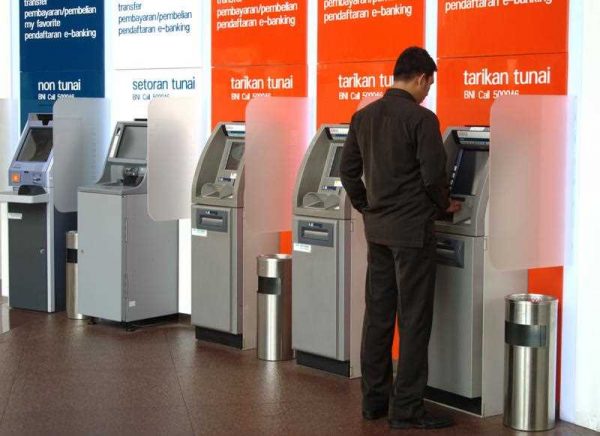In 1997, Indonesia’s budget was almost balanced. This was the result of tight fiscal and debt rules, as the entire budget deficit was financed by overseas development assistance from a consortium of Indonesia’s Western creditors. The current account deficit was also manageable at around 3–4 per cent of GDP. But this did not prevent the crisis.
The banking sector is the core of the financial industry in Indonesia and the main source of external financing for the corporate sector. In January–February 1998 the banking system collapsed. Bank runs and capital flight drained foreign exchange reserves. Not even Bank Indonesia (BI), the central bank, could provide loans of more than a few months maturity. Interest rates rose to over 80 per cent in 1997. Inflation rose to 58 per cent in 1998 and the economy shrank by over 13.1 per cent.
Four weaknesses in the financial system explain Indonesia’s capitulation to crisis. First, the undercapitalisation of the banking system left it open to risk. Second, there was substandard regulation and supervision, particularly in enforcing compliance with capital adequacy ratios and legal lending limits, and vigilance about foreign exchange exposure and derivatives. Third, a lack of inter-bank competition. Public sector wealth (including that of state-owned enterprises) was exclusively deposited with a group of state-owned banks, which controlled over 60 per cent of the market. Fourth, the availability of cheap credit from state-owned banks with low risk provided no incentive for the corporate sector to raise funds in the capital and bond markets.
BI records foreign borrowings of banks, but regulations on borrowing were generally violated. Foreign borrowings of the corporate sector were not recorded. Nearly all corporate foreign borrowings were short term and unhedged but were used to finance long-term projects in non-traded sectors of the economy. These were mainly land-based industries that only generate income in rupiah. This caused double maturity mismatches, namely: currency and maturity.
The crisis ended the financial repression that had been practised during the 32-year rule of President Suharto. Under Suharto the government set specific credit ceilings concerning the use of credit, which were applicable by economic sector, class of customer and individual borrowers. Interest rates were set below inflation rates and credit risks were assumed by Askrindo, the state-owned credit insurance company, BI and the Ministry of Finance.
Between 1997 and 2013, the Indonesian government adopted a number of policies to rebuild and modernise Indonesia’s financial sector.
The first policy was to provide emergency liquidity and purchase sovereign bonds to restore capital adequacy of financially distressed banks. Non-viable banks were immediately closed or restructured. To clean up their books, sour assets of the viable banks were also restructured, while their foreign liabilities were taken over by the government.
The second policy was to create a banking safety net through a deposit guarantee. This restored public confidence in the banking system and stopped destabilising bank runs in 1997.
The third strategy was to overhaul regulatory oversight by adopting risk-oriented banking supervision according to Basel principles and by reforming the accounting system. Modelled after the Financial Sector Authority of the UK, the OJK (Otoritas Jasa Keuangan, Financial Services Authority) was established in 2010 to regulate and supervise all financial sectors. BI focuses on macroeconomic prudential policies to guard against systemic risk. The Financial Stability Forum was also created in 2007 to facilitate cooperation, coordination and exchange of information between the Ministry of Finance, BI and the state-owned Credit Insurance Company (LPS) to better maintain financial stability. But institutions and the legal system remain weak as they cannot properly protect private property rights or enforce business contracts.
Fourth was to modernise the payment system by introducing real time gross settlements and modern communication technologies to ensure interbank transactions are timely and safe. This reduces the need for cash, excess reserves and overdrafts. Previously, under the Suharto administration, these technologies were only available to Bank Central Asia, which is jointly owned by Suharto’s family and business cronies.
The fifth strategy has been to restructure BI and the banking system. Modelled after the Bundesbank of Germany, BI was made into an independent institution in 1999 with a single objective: to achieve the target inflation rate.
The sixth policy was to partially privatise the state-owned banks, while keeping a controlling stake in state hands. Indonesia’s state-owned banks remain heavily protected and are public sector failures with weak governance.
Lastly, the government ended financial repression and floated sovereign bonds. This helped to both recapitalise the banking system and finance budget deficits that encouraged the development of capital and bond markets. The end of cheap credit with its subsidised interest rate and low credit risk provides an incentive for the corporate sector to raise funds in these markets. But Indonesia has no strong institutional investors to absorb sovereign bonds. At present, nearly 40 per cent of liquidity in domestic capital and bond markets is made up of volatile, short-term capital inflows.
It is through these policies that the Indonesian government has effectively reduced risks and moved Indonesia towards a modern financial system.
Anwar Nasution is Emeritus Professor of Economics at the University of Indonesia, Jakarta. He is the editor of the 2015 book Macroeconomic Policies in Indonesia: Indonesia economy since the Asian financial crisis of 1997, from which this article is digested.

